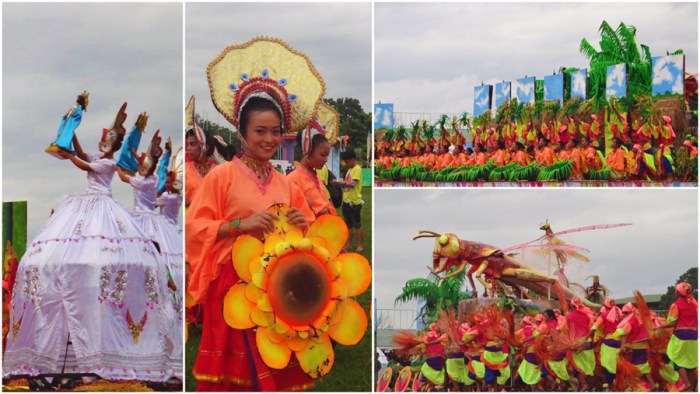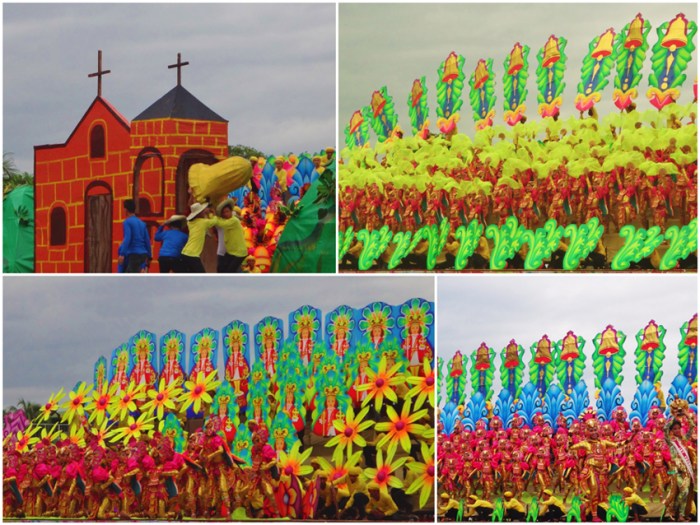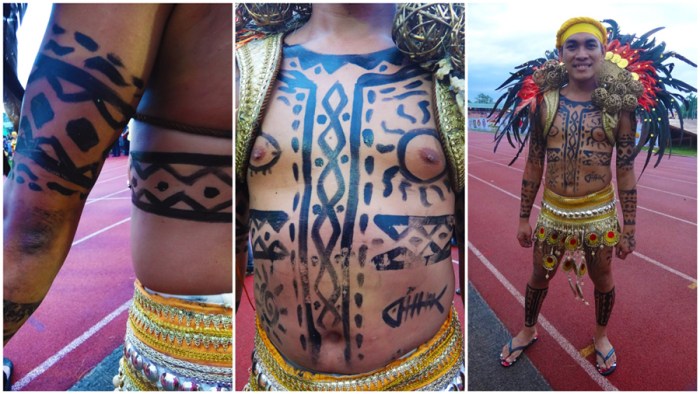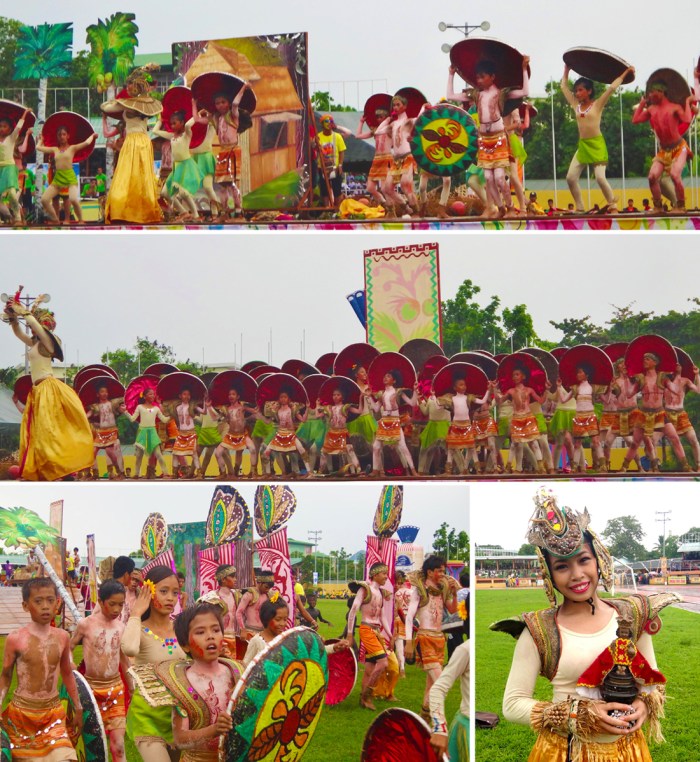While the skies were a gloomy gray monochrome last Saturday, the stadium and grounds of Leyte Sports Development Center at Tacloban City, Leyte, were in a festive mood. Though the morning street dance was regrettably canceled because of the continuous downpour, the afternoon performances of the Pintados-Kasadyaan Festival contingents adorned the stage with vibrant, dancing colors.
And, the Pintados contingents who performed first especially exhibited their warrior spirits by dancing – and maintaining their balance – on a stage slickened by the morning rains.
A glimpse of the Pintados-Kasadyaan Festival champions. (Top) Tribu Bungkaras for Pintados (Bottom) Buyogan Festival for Kasadyaan
The Pintados-Kasadyaan Festival is actually two festivals. The celebration of the Pintados Festival is inspired by tattooed warriors in early Visayas. Tattoos then were a mark of bravery and beauty. Tattooing itself was an act of bravery as it was not as medically safe as today; those who got tattoos then risked contracting infections.
The Spaniards were fascinated with the warriors’ artistic tattoos and decided to include them in a celebration together with the Feast Day of Santo Niño, the Holy Child Jesus.
Each year, since 1987, men and women painted usually from head to toe also paint the streets of Tacloban with color.
This Pintados dancer’s body from the Kasiruman contingent is painted to resemble early warriors’ tattoos. He claimed that in painting these patterns, the artist stayed faithful to the tattoos of the old.
The Kasadyaan Festival is inspired by the Feast Day of Santo Niño and is considered the “festival of festivals” because its contingents perform the festival dances of their respective municipalities. “Kasadyaan” means merriment. The festival is celebrated yearly since 1996.
Both the Pintados and Kasadyaan are now held every June 29, the Feast Day of Santo Niño.
On June 29 this year, while all contingents were bursting with both color and energy, the winners stood out. Personally, I would pick them too.
Pintados Festival
Third Place: Tribu Manangguite, Barangay Sagkahan, Tacloban City
In their performance, the dancers prominently displayed manangguite (coconut tree), their source of food and livelihood. The manangguites seem to be sentient too, as one helped out a boy possessed with bad spirits. He implored to Santo Niño to heal the boy. But, while the boy was healed, famine and outbreak spread over the land. But the people kept their faith on Santo Niño and were restored to health and abundance.
Second Place: Tribu Kasiruman, Barangay San Jose, Tacloban City
The story portrayed by the Kasiruman contingent was quite straightforward but powerful. In the hunting village of San Jose, the hunters became the hunted – a giant black bird and small black birds attacked them, but they fought back and the strongest was able to kill the biggest bird. He fell ill upon returning to the village, though, but was healed through the intervention of Santo Niño. He was tattooed to recognize his bravery and kindness.
 First Place: Tribu Bungkaras, Barangay San Roque, Tolosa, Leyte
First Place: Tribu Bungkaras, Barangay San Roque, Tolosa, Leyte
The Pintados champion is also my favorite among the Pintados contingents. “Bungkaras” refers to the golden drum used by the community in their ritual dances and offerings to their gods and goddesses. Its music also served as their protection against yawas¸ evil spirits. A yawa, though, was able to trick the babaylan, the head and the healer of the tribe, into exchanging the bungkaras for a bigger and more attractive musical drum. When the community beat the new drum, sickness and chaos befell their land.
Santo Niño then came to save the day, returned the bungkaras to the tribe, and restored order in the community.
Kasadyaan Festival
Third Place: Viajedores Festival, La Paz, Leyte
The Viajedores dancers portrayed the fertility of their land with their plants and harvests. A swarm of locusts ravaged their rice and corn fields (which actually happened twice during the 1940s), though, but with their faith on Santo Niño and their patron saint Nuestra Señora de la Paz y Buen Viaje, they prevailed over hardships.
 Second Place: Lingganay Festival, Alangalang, Leyte
Second Place: Lingganay Festival, Alangalang, Leyte
For me, Lingganay is hands down the most colorful festival at Pintados-Kasadyaan. Pinks, purples, yellows, greens, blues, and reds – it seems that every few seconds the stage changes color.
This contingent spectacularly dramatized the story of their golden bell also with a golden sound, a treasure kept in the community church and which almost fell on Moro pirates’ hands. Rather than have Moros steal their bell, the people of Alangalang dropped the bell into the deepest part of the lake. Even though they searched for the bell, they never found it. The community still thrived even in the bell’s absence, and with faith in Santo Niño.
 First Place: Buyogan Festival, Ambuyog, Leyte
First Place: Buyogan Festival, Ambuyog, Leyte
Buyogan is a delightful and whimsical presentation of bees playing among flowers then going home to their hives afterwards. One bee had a run-in with a giant mantis, though, and was captured. The villagers and a swarm of bees came to rescue the little bee. Meanwhile, Santo Niño came to heal the bee of his injuries, prompting a community celebration.
 I was particularly dazzled with the Lingganay and Buyogan festivals, which I heard were consistent winners during the years they joined the competition.
I was particularly dazzled with the Lingganay and Buyogan festivals, which I heard were consistent winners during the years they joined the competition.
I liked the Pintados too, but what I would like to see more in the presentations is an emphasis on the role and the power of the warriors and their tattoos; this year they were somehow overshadowed by Santo Niño’s immense power who cures every sickness and solves every conflict.
The Kasiruman contingent’s performance, though, was able to beautifully marry the power of the warriors and the power of Santo Niño in their presentation.
I hope next year will exhibit more of the Pintados warrior spirit.
Festival fireworks at the end of the show
Pintados-Kasadyaan Festival is held every June 29 in Tacloban City, Leyte. To get to Tacloban, you can fly in from Manila or Cebu.







ang tyaga mo mag-kwento… hehehe! thanks sa info… 🙂
🙂
I have been in an actual Festival celebration (well except in my hometown). Hope will experience it soon!
Pingback: Finding Zen In An Unexpected Place | Traveling Light
Thank you for your own article, it’s very useful, will surely try to try things out what you have indicated… there is certainly only one thing I want to discuss in more detail, My spouse and i wrote an email to your deal with about it.
Pingback: Pintados-Kasadyaan Festival to have “low-key” celebration this year | DWDD
thank you po sa nag post nito alam kupo na mahirap mging pintados model nang pintados pwede po kayong matalo o manalo ok lng po na matalo basta na try nyo po best nyu na ip-akita sa tao ang talento nang dugong pilipino at dugong pilipino heartsrtong po 🙂
-Christine Naranja